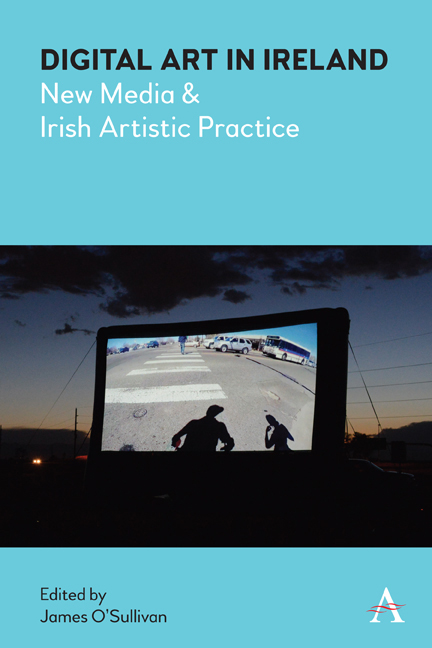Book contents
- Frontmatter
- Dedication
- Contents
- List of Illustrations
- Acknowledgements
- Notes on Contributors
- Chapter 1 Introduction: Digital Art in Ireland
- Chapter 2 Strange Mothers: The Maternal and Contemporary Media Art in Ireland
- Chapter 3 Between Aesthetics and Institutions: Irish Electronic Poetry
- Chapter 4 ‘to shine upon the original all the more fully’: Contemporary New Media Adaptations of James Joyce
- Chapter 5 Art in the Data-City: Critical Data Art in the Age of Surveillance Capitalism
- Chapter 6 Experimental Arcade Video Games as Self-Reflexive Media Art
- Chapter 7 Folding, Unfolding, Refolding Sound Claire Fitch
- Chapter 8 Treacherous Images and Animal Gazes: Ailbhe Ní Bhriain's Reports to an Academy, 2015
- Chapter 9 Pressing Send: Distribution and Curation in Irish New Media Art
- Index
Chapter 1 - Introduction: Digital Art in Ireland
Published online by Cambridge University Press: 23 February 2022
- Frontmatter
- Dedication
- Contents
- List of Illustrations
- Acknowledgements
- Notes on Contributors
- Chapter 1 Introduction: Digital Art in Ireland
- Chapter 2 Strange Mothers: The Maternal and Contemporary Media Art in Ireland
- Chapter 3 Between Aesthetics and Institutions: Irish Electronic Poetry
- Chapter 4 ‘to shine upon the original all the more fully’: Contemporary New Media Adaptations of James Joyce
- Chapter 5 Art in the Data-City: Critical Data Art in the Age of Surveillance Capitalism
- Chapter 6 Experimental Arcade Video Games as Self-Reflexive Media Art
- Chapter 7 Folding, Unfolding, Refolding Sound Claire Fitch
- Chapter 8 Treacherous Images and Animal Gazes: Ailbhe Ní Bhriain's Reports to an Academy, 2015
- Chapter 9 Pressing Send: Distribution and Curation in Irish New Media Art
- Index
Summary
What do we mean by ‘digital art’? Much art, as one would expect with any type of cultural production in the twenty-first century, is framed by the digital. But art which is digitally remediated only so that it can be stored or shared via computers is not necessarily digital art. Acts of digitisation can change aspects of a work and influence reception, but if we are to see digital art as a distinct formal category, then we must recognise the distinction in works which draw upon new media as an essential part of the creative process. And yet, many works of digital art owe a debt to the analogue arts, to non-digital processes and materials, indeed, many digital works might feature a mix of forms. As the editor of this volume, I believe that digital art is fundamentally digital; it is art which cannot happen without some contemporary media technology, some element of computation, some bit-based machine. And yet, as many of the contributions to this collection will show, the digital can co-exist within a constellation of aesthetics, including its non-digital others.
As articulated by Christiane Paul, one of the foremost scholars and curators of the form, ‘Digital art is predominantly understood as digital-born, computable art that is created, stored, and distributed via digital technologies and uses the features of these technologies as a medium’ (2016, 2). Perhaps this book might be seen, in the first instance, as a response to Paul's position. However classified, digital art goes by a lot of names – new media art, electronic art, computational art, net art, screen-based art – but generally, this is a domain in which the objects of discussion rely, either absolutely or in part, on digital technologies to achieve their artistic purpose.
In the summer of 2019, I had the pleasure of co-curating, with Chris Clarke, an exhibition at the Glucksman gallery in Cork city (Clarke and O’Sullivan 2019). Titled Peripheries, the show was part of University College Cork's hosting of ELO2019, the first time that the annual Electronic Literature Organization Conference & Media Arts Festival was held on Irish shores (O’Sullivan 2019).
- Type
- Chapter
- Information
- Digital Art in IrelandNew Media and Irish Artistic Practice, pp. 1 - 8Publisher: Anthem PressPrint publication year: 2021



